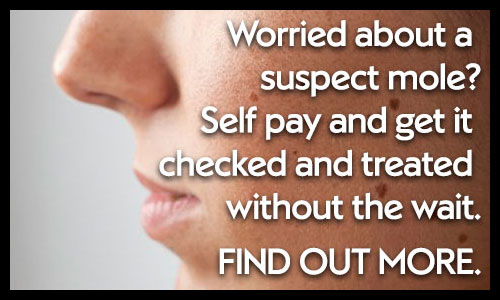How to check a mole
- Overview
Melanoma is the fifth most common cancer in the UK, with over 16,000 people being diagnosed with melanoma in the UK every year (Source: Cancer Research UK). So skin cancer isn't just a problem in the southern hemisphere, it’s on our doorsteps.
It can be difficult to tell the difference between a non-cancerous mole and a cancerous one, particularly if you have a lot of moles or freckles. But there are some tell-tale signs that you can look out for. The A – G method below provides a good basis for identification of potentially troublesome moles.
What to look for when checking a mole
A - Asymmetry
Normal moles or freckles are completely symmetrical. If you were to draw a line through a normal spot, you would have two symmetrical halves. In cases of skin cancer, spots don't look the same on both sides.
B - Border
A mole or spot with blurry and/or jagged edges.
C - Colour
A mole that is more than one hue is suspicious and needs to be evaluated by a doctor. Normal spots are usually one colour. This can include lightening or darkening of the mole. Melanoma cells usually continue to produce melanin, which accounts for the cancers appearing in mixed shades of tan, brown and black.
D - Diameter
If it is larger than a pencil eraser (about 1/4 inch or 6mm), it needs to be examined by a doctor. This includes areas that do not have any other abnormalities (colour, border, asymmetry). But, don't be fooled by size alone - it can be smaller.
E - Elevation/Evolving
Elevation means the mole is raised above the surface and has an uneven surface. Evolving means changing in size, shape, colour.
F – From firm to palpation
This means if any of your moles change from a softer, spongier consistency to a firm consistency.
G – Growing progressively over 1 month
A mole should remain a consistent size. If your mole continues to grow over more than a month, speak to your doctor.
When to get a mole checked
Moles can develop on any area of your skin, so you should check yourself thoroughly at least once a month using the A – G method provided above. If you notice something unusual or concerning, speak to your doctor immediately for advice. They may advise mole mapping or mole assessment.
Ways to reduce your melanoma risk
Skin damage, especially sunburn, from UV rays is the biggest avoidable risk factor for melanoma. With many people visiting hot and sunny locations during the summer, the risk of getting sunburnt is raised, but there are steps you can take to protect yourself. Unfortunately, many people continue to focus on getting tanned on holiday, and there is a false belief that a little sunburn is okay. You should aim to avoid excessive sun exposure when you are outside.
Here are some ways you can reduce your risk of getting skin damage from UV rays:
- Use sun cream before you go out in the sun and re-apply it regularly throughout the day. When you go swimming, you will need to put on fresh sun cream afterwards. If you are lighter-skinned, have lighter coloured eyes, naturally blonde or red hair, or if you already have a lot of freckles you will need to be particularly careful. You should aim to use sun cream that has a higher SPF rating of 30 or above
- Wear clothing that limits the areas of your skin directly exposed to the sun. Clothes made of lighter fabrics are useful for keeping you cool, and a cap or sun hat will protect your face. Sunglasses are also important for shielding your eyes
- Duck into the shade regularly to limit your time in direct sunlight. Avoid the sun when it is at its strongest during the middle part of the day
- Stay away from tanning beds as these also produce harmful UV rays that can damage your skin
Last updated Thursday 6 April 2023
First published on Monday 23 May 2016


